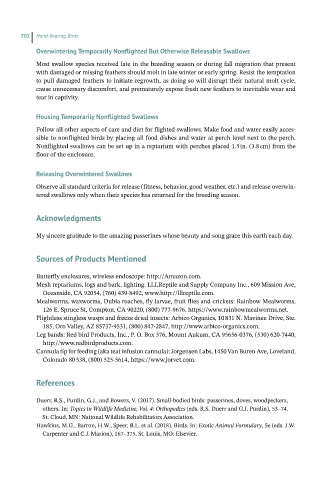Page 701 - Hand rearing birds second
P. 701
702 Hand-Rearing Birds
OverwinteringTemporarilyNonflightedButOtherwiseReleasableSwallows
Most swallow species received late in the breeding season or during fall migration that present
with damaged or missing feathers should molt in late winter or early spring. Resist the temptation
to pull damaged feathers to initiate regrowth, as doing so will disrupt their natural molt cycle,
cause unnecessary discomfort, and prematurely expose fresh new feathers to inevitable wear and
tear in captivity.
HousingTemporarilyNonflightedSwallows
Follow all other aspects of care and diet for flighted swallows. Make food and water easily acces-
sible to nonflighted birds by placing all food dishes and water at perch level next to the perch.
Nonflighted swallows can be set up in a reptarium with perches placed 1.5 in. (3.8 cm) from the
floor of the enclosure.
ReleasingOverwinteredSwallows
Observe all standard criteria for release (fitness, behavior, good weather, etc.) and release overwin-
tered swallows only when their species has returned for the breeding season.
Acknowledgments
My sincere gratitude to the amazing passerines whose beauty and song grace this earth each day.
Sourcesof ProductsMentioned
Butterfly enclosures, wireless endoscope: http://Amazon.com.
Mesh reptariums, logs and bark, lighting: LLLReptile and Supply Company Inc., 609 Mission Ave,
Oceanside, CA 92054, (760) 439‐8492, www.http://lllreptile.com.
Mealworms, waxworms, Dubia roaches, fly larvae, fruit flies and crickets: Rainbow Mealworms,
126 E. Spruce St, Compton, CA 90220, (800) 777‐9676. https://www.rainbowmealworms.net.
Flightless stingless wasps and freeze dried insects: Arbico Organics, 10 831 N. Mavinee Drive, Ste.
185, Oro Valley, AZ 85737‐9531, (800) 847‐2847, http://www.arbico‐organics.com.
Leg bands: Red bird Products, Inc., P. O. Box 376, Mount Aukum, CA 95656‐0376, (530) 620‐7440,
http://www.redbirdproducts.com.
Cannula tip for feeding (aka teat infusion cannula): Jorgensen Labs, 1450 Van Buren Ave, Loveland,
Colorado 80 538, (800) 525‐5614, https://www.jorvet.com.
References
Duerr, R.S., Purdin, G.J., and Bowers, V. (2017). Small‐bodied birds: passerines, doves, woodpeckers,
others. In: Topics in Wildlife Medicine, Vol. 4: Orthopedics (eds. R.S. Duerr and G.J. Purdin), 53–74.
St. Cloud, MN: National Wildlife Rehabilitators Association.
Hawkins, M.G., Barron, H.W., Speer, B.L. et al. (2018). Birds. In: Exotic Animal Formulary, 5e (eds. J.W.
Carpenter and C.J. Marion), 167–375. St. Louis, MO: Elsevier.

